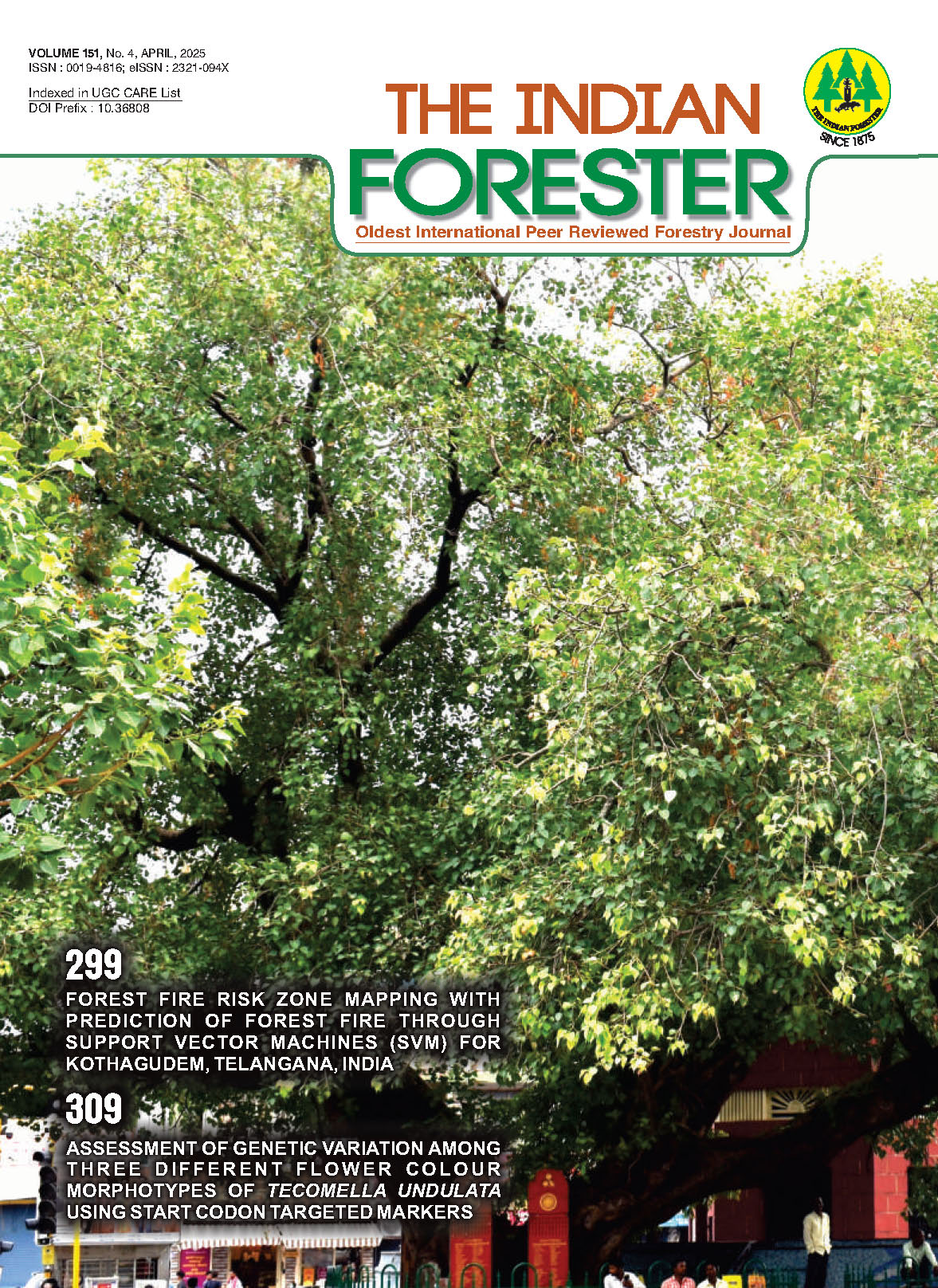Documentation of Non-Timber Forest Products of Haveri District, Karnataka
DOI:
https://doi.org/10.36808/if/2025/v151i4/170608Keywords:
Utilization, NTFP, Forest resource, Haveri District. Karnataka.Abstract
The present work is an inventory of non-timber forest products in Haveri District, it resulted in a total of 64 species and 56 genera, belonging to 32 families were recorded yielding 67 non-timber forest-yielding products of 8 different categories namely, Food, fodder, cosmetics, dye-yielding, handicrafts, construction materials, exudates, biodiesel and green manure yielding plants. Fabaceae is a most dominant family with the highest number of 11 species. Habit-wise analysis shown that tree species are dominant with 35 species, followed by herbs (16), shrubs (10) and climbers (3). Proper collection, processing and marketing of NTFPs provides self-employment to the people livelihoods. Conservation and management plans for sustainable utilization of these products is recommended to overcome the threat of habitat loss by anthropogenic activities.
References
Ahenkan A. and Boon E. (2011). Non-timber forest products (NTFPs): Clearing the confusion in semantics. Journal of Human Ecology, 33(1): 1-9. DOI: https://doi.org/10.1080/09709274.2011.11906342
Anish K. and Srinidhi N.S. (2023). Mapping of the NTFP Species of Forest College and Research Institute (FCRI), Telangana Using Geospatial Technology. Indian Forester. 149(3): 291-297. DOI: 10.36808/if/2023/v149i3/165680. DOI: https://doi.org/10.36808/if/2023/v149i3/165680
Baidoo A. (2018). Non-timber forest products (NTFPs): Snapshot of emerging definitions.
FAO (1999). (Food and Agriculture Organisation). An Overview of Non-Timber Forest Products in the Mediterranean Region. Rome: FAO, pp. 1-9.
Gamble J. S. and Fischer C.E.C. (2008). Flora of the Presidency of Madras 11 parts (1-7 Gamble & 8-11 by Fischer), Bishen Singh Mahendra Pal Singh, Dehradun. (Reprint edition).
Garg Seema (2013). Working Plan of Haveri Division; Period (2013-14 to 2022-23). Chief Conservator of Forests (Project) Bangalore.
Hanumantha M., Bisanalli S.I., Patil R.S. and Manjunatha G.O. (2019). Utilization pattern of non-timber forest products (NTFPS) in Siddapura taluk of Uttara Kannada district of Western Ghat region, Karnataka. Journal of Pharmacognosy and Phytochemistry, 8(3): 901-905. https://surveyofindia.gov.in/ https://www.ipni.org/
Jain S.K. and Rao R.R. (1977). Field and Herbarium Methods. Today & Tomorrow Publishers, New Delhi.
Makanur N.S. and Kotresha K. (2022). Vascular plants of Bankapura Peacock Conservation Reserve, Karnataka, India. Indian Journal of Forestry, 45(3): 169-178. https://doi.org/10.54207/bsmps1000-2023- 1B6XRZ DOI: https://doi.org/10.54207/bsmps1000-2023-1B6XRZ
Menon P. (2002). Checklist and approximate quantity of nonwood forest produce (NWFP) collected from Peppara Wildlife Sanctuary. https://lib.icimod.org/record/11074/files/161.pdf.
Murthy I.K., Bhat P.R., Ravindranath N.H. and Sukumar R. (2005). Financial valuation of non-timber forest product flows in Uttara Kannada district, Western Ghats, Karnataka. Current Science, pp.1573-1579.
Pandey A.K., Tripathi Y.C. and Kumar A. (2016). Non-timber forest products (NTFPs) for sustained livelihood: Challenges and strategies. Research Journal of Forestry, 10(1): 1-7. DOI: https://doi.org/10.3923/rjf.2016.1.7
Prakash S., Prakash S.S. and Krishna V. (2006). Participation behavior of Indigenous people in extraction and marketing of non-timber forest products in the dry deciduous forests of South India. Journal of Tropical Forestry, 22: 1-11.
Rajasab A. H. and Isaq M. (2004). Documentation of folk knowledge on edible wild plants of North Karnataka. Indian J. Traditional knowledge, 3(4): 419-429.
Ros Tonen M., Dijkman W. and Van Bueren E.L. (1995). Commercial and sustainable extraction of non-timber forest products: Towards a policy and management-oriented research strategy. Tropenbos Foundation.
Sadashivappa P., Suryaprakash S. and Vijaya Krishna V. (2006). Participation behavior of indigenous people in nontimber forest products extraction and marketing in the dry deciduous forests of South India. In Conference on International Agricultural Research for Development, Tropentag University of Bonn, October (pp. 11-13).
Saldanha C.J. (1984). Flora of Karnataka. Vol. I. Oxford & IBH Publishing, Co. Pvt. Ltd, New Delhi.
Saldanha, C.J. (1996). Flora of Karnataka. Vol. II. Oxford & IBH Publishing, Co. Pvt. Ltd, New Delhi.
Shiva M.P. and Verma S.K. (2002). Approaches to sustainable forest management and biodiversity conservation. International Book Distributors, Dehradun.
Siddeshwari M and Kotresha K. (2023). Non-Timber Forest Products of Koppal District, Karnataka: Indigenous Use. International Journal for Multidisciplinary Research, 5(5): 1-10. DOI: https://doi.org/10.36948/ijfmr.2023.v05i05.7903
World Bank (2006). Unlocking opportunities for forestdependent people in India. Main Report No. 34481-IN, 1, February 2006, India.
Downloads
Downloads
Published
How to Cite
Issue
Section
License
Unless otherwise stated, copyright or similar rights in all materials presented on the site, including graphical images, are owned by Indian Forester.





